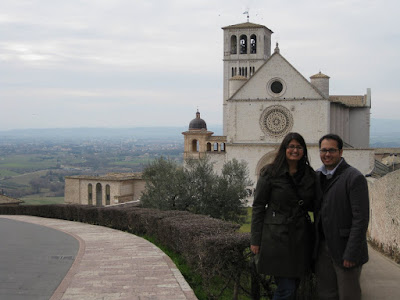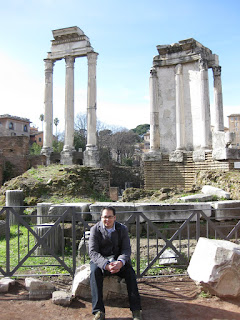We spent 4 days in Siena, a *medieval* tuscan town that has not only been perfectly preserved, but is completely modern...there are stores of each and every kind from dollar (euro actually) stores to Bata, all housed in buildings dating back to the 12th and 13th centuries. There are several universities within the city walls so the town is quite young and fashioable.
I really liked Siena, due in large part to its central square, Piazza dei Campo. It is oddly modern for being built back in the 13th century: the piazza is not flat but instead slopes inward from all angles to a single point at the edge. We spent many days sitting here when the weather was nice. The Campo looked like this:
The castle like building, the Piazza Publico, has a very tall tower, the tallest standing medieval tower in italy. R was perfectly happy to sit in the piazza one sunny afternoon when i decided to climb the 500+ steps to the top. The view was amazing, and the climb to the top terrifying. There was a warning at the beginning that said if you have heart or respiritory conditions, are clausterphobic (i am), afraid of heights (i might be), "or prone to giddiniess" (no idea what that means), you should not go up the tower. I did anyhow. The stairs were shorter than my feet, the walls were narrower than my shoulders, and at times the ceiling was lower than my head, so this involved alot of sideways crawling. It was also bad news when you ran into someone going the opposite direction from you, because it ment one person had to back track a few flights. In any case, it was easily worth the adventure, the view from up to was amazing. It looked like this:
The duomo (cathedral) in Siena was maybe my favorite so far. The church is oddly colored, sea green, pink, and off-white, and each color is achieved through the use of solid marble. The effect was pretty surreal. The duomo looked like this:
Finally, on our last day, after walking up and down alot of very steep hills, we found that this city, amid its 800 year old buildings, has an escalator! the escalator looked like this:






































